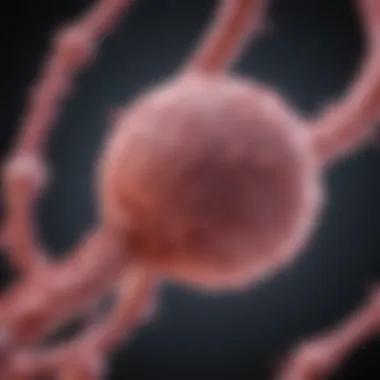Understanding Double Negative Breast Cancer: Insights and Implications


Intro
Double negative breast cancer (DNBC) is an important subtype in the broader category of breast cancer. It lacks both hormone receptors for estrogen and progesterone as well as the HER2 protein. This unique combination poses significant challenges for treatment options and influences patient outcomes. In recent years, increased attention has been drawn to this subtype, emphasizing the need for a deeper understanding of its underlying mechanisms, diagnostic approaches, and potential therapies. This article seeks to dissect the multifaceted nature of DNBC, catering primarily to an audience consisting of students, researchers, educators, and professionals who require a thorough grasp of the topic.
Key Concepts
Definition of the Main Idea
Double negative breast cancer is defined by its absence of critical biomarkers that typically guide treatment in other breast cancer subtypes. Patients with DNBC do not express estrogens or progestogens receptors and are not HER2 positive. This diminishes the efficacy of standard therapies, particularly hormone therapies and HER2-targeted treatments. The classification of DNBC as a distinct entity is essential. This distinction allows for more tailored clinical approaches and impactful research efforts.
Overview of Scientific Principles
To appreciate DNBC, it is crucial to explore its biological underpinnings. In most breast cancers, hormone receptors play a vital role in tumor growth, and targeted therapies have transformed patient outcomes significantly. However, DNBC evolves differently. Research indicates that DNBC may stem from various genetic mutations and environmental factors that trigger aggressive tumor behavior. Some studies suggest a correlation between DNBC and basal-like breast cancer, which is typically associated with poorer prognosis due to its aggressive nature.
"Understanding the unique profile of double negative breast cancer can inform better therapeutic strategies and improve patient care."
"Understanding the unique profile of double negative breast cancer can inform better therapeutic strategies and improve patient care."
Current Research Trends
Recent Studies and Findings
Current research into DNBC emphasizes the importance of genetic studies to uncover specific mutations and potential therapeutic targets. For instance, studies are focused on examining the role of the tumor microenvironment and its influence on cancer progression. Other research tracks the efficacy of immunotherapy in patients with DNBC. Researchers are exploring how immune checkpoint inhibitors might offer new avenues for treatment in this challenging subtype.
Significant Breakthroughs in the Field
Recent breakthroughs include advancements in molecular profiling that help identify unique features of DNBC. For example, liquid biopsies are becoming a promising tool for monitoring treatment responses and recurrence. Clinical trials are also prioritizing novel combinations of therapies, aiming to find more effective treatment regimens for patients suffering from this subtype, whose options have traditionally been limited.
Understanding the complexities of double negative breast cancer is paramount. As research continues to unfold, the hope is to refine diagnostic criteria and reveal effective therapeutic strategies to improve patient care.
Prologue to Double Negative Breast Cancer
Definition
Double negative breast cancer is defined as a subtype of breast cancer characterized by the absence of both hormone receptors—estrogen and progesterone—and the HER2 protein. This classification leads to a distinct set of biological behavior and clinical outcomes compared to other breast cancer types. Its lack of these receptors often results in limited treatment options since many targeted therapies rely on the presence of these markers for efficacy.
The absence of these receptors complicates not only the treatment pathways but also the overall biological understanding of how this cancer presents and evolves over time. Thus, accurate definition and classification are vital for developing effective treatment strategies.
Prevalence and Epidemiology
The prevalence of double negative breast cancer is relatively low compared to more common subtypes such as hormone-receptor positive and HER2-positive cancers. Estimates suggest that double negative breast cancer accounts for about 10-15% of all breast cancer cases. Epidemiologically, this subtype is more frequently diagnosed in younger women and is associated with more aggressive tumor characteristics.
Research indicates that specific genetic factors may contribute to the higher occurrence of double negative breast cancer in certain populations. Studies show diverse incidence rates based on ethnicity and genetic backgrounds, suggesting a need for targeted research focusing on these demographic variations.
In summary, understanding both the definition and prevalence of double negative breast cancer is crucial for clinicians and researchers. It lays the groundwork for recognizing the importance of tailored treatment strategies and the necessity for ongoing research in this area.
Biological Characteristics
The biological characteristics of double negative breast cancer play a crucial role in understanding this unique subtype. Characterized by the absence of hormone receptors and HER2 proteins, these features fundamentally influence the behavior of the cancer, its response to treatments, and overall patient outcomes.
Understanding these characteristics is essential for several reasons. First, it helps identify the most effective treatment options. The lack of hormone receptors means that traditional therapies targeting estrogen and progesterone are ineffective. Additionally, the absence of HER2 highlights the ineffectiveness of HER2-targeted therapies like trastuzumab. A nuanced understanding of these characteristics informs tailored therapy, addressing the specific biological context of the cancer.
Hormone Receptor Status


The hormone receptor status is one of the defining features of double negative breast cancer. By definition, these tumors do not express estrogen receptors (ER) or progesterone receptors (PR). This lack of hormone receptor expression limits the use of hormonal therapies, which are commonly used in other breast cancer subtypes such as hormone receptor-positive cancers.
Research indicates that double negative breast cancer can behave more aggressively than hormone receptor-positive diseases. This aggressive behavior is often associated with higher rates of metastasis and more challenging treatment landscapes.
HER2 Negativity
HER2 negativity is another critical characteristic of double negative breast cancer. HER2 is a protein that can promote the growth of cancer cells. In about 20% of breast cancers, overexpression of HER2 is common, which allows for targeted therapies to be effective, such as trastuzumab and pertuzumab.
The absence of HER2 means that these targeted therapies cannot be employed, often resulting in limited treatment options. This can create a challenging scenario for oncologists working to create an effective treatment plan. Patients with double negative breast cancer may also have a poorer prognosis due to the lack of these targeted therapies.
Genetic and Molecular Features
Double negative breast cancer is also defined by specific genetic and molecular characteristics. Studies have shown that these tumors may exhibit unique genomic alterations. Such alterations can include mutations in the TP53 gene, which is often linked to aggressive disease outcomes.
Additionally, molecular profiling can reveal particular pathways that might be targeted in the future. For example, research is ongoing to explore the potential of PARP inhibitors, which may be effective for women with mutations that alter DNA repair pathways.
"The genetic landscape of double negative breast cancer is a key area of active investigation and may uncover potential therapeutic targets."
"The genetic landscape of double negative breast cancer is a key area of active investigation and may uncover potential therapeutic targets."
The biological characteristics of double negative breast cancer significantly impact the approach to diagnosis and treatment. They dictate how the disease is managed and necessitate an ongoing evolution in treatment strategies. Understanding these factors is essential for researchers and healthcare professionals involved in the care of patients affected by this complex subtype.
Clinical Implications
Understanding clinical implications of double negative breast cancer is crucial for guiding diagnosis and treatment decisions. This subtype presents specific challenges, primarily due to its lack of hormone receptors and HER2 protein. These characteristics mean that standard hormonal and targeted therapies are not effective. Therefore, medical professionals must navigate through various diagnostic tools and develop tailored treatment strategies.
Diagnosis
Imaging Techniques
Imaging techniques play an essential role in the diagnosis of double negative breast cancer. These methods help in detecting tumors, assessing tumor size, and determining the extent of disease spread. Techniques like mammography, ultrasound, and magnetic resonance imaging (MRI) are commonly used. Each method has unique capabilities:
- Mammography is simple and widely available, making it a popular choice for routine screening.
- Ultrasound provides detailed images of soft tissues and can assist in distinguishing between solid and cystic lesions.
- MRI is more sensitive and can provide additional information, especially in dense breast tissue.
However, these imaging techniques can also have drawbacks. For example, MRI may have higher costs and longer wait times.
Biopsy Procedures
The biopsy procedure is vital for confirming the diagnosis of double negative breast cancer. This process involves taking a sample of breast tissue for pathological evaluation. Common biopsy techniques include fine needle aspiration, core needle biopsy, and excisional biopsy.
The key characteristic of biopsy is its ability to provide definitive information about the cancer type and its characteristics. Core needle biopsies are often favored due to their accuracy and less invasive nature compared to excisional biopsies. However, a core needle biopsy may not capture the entire tumor, limiting the assessment of heterogeneity.
Pathological Assessment
Pathological assessment is the backbone of confirming double negative breast cancer and classifying its various aspects. Once the tissue is obtained, pathologists examine it under a microscope for malignant cells.
This step is critical as it helps in determining the grade of the tumor, presence of necrosis, and other biomarker expressions. Pathological assessment can differentiate between tumor subtypes, which informs treatment options. One limitation is that this process relies heavily on the skill of the pathologist, and errors may lead to misdiagnosis.
Prognostic Factors
Survival Rates
Survival rates are a crucial metric in understanding outcomes for patients with double negative breast cancer. They indicate the percentage of patients who survive for a specific time after diagnosis and are influenced by numerous factors, including tumor stage at diagnosis and treatment response.
Currently, double negative breast cancer has lower survival rates compared to other subtypes, mainly due to late diagnosis and limited treatment options. The unique feature of survival rates is that they provide benchmarks that can guide patient expectations and treatment planning. However, it is essential to consider these rates as averages; individual patient prognosis can vary significantly depending on personalized factors.


Recurrence Patterns
Recurrence patterns inform clinicians about the likelihood of the cancer returning after initial treatment. For double negative breast cancer, patterns are often more aggressive and can lead to distant metastasis. The key aspect of recurrence patterns is their integration with treatment protocols; understanding these helps in tailoring follow-up plans.
One unique feature is the variability among patients based on biological characteristics. Monitoring recurrence must consider not just statistical averages but also individual behaviors of the cancer. This means clinicians need to maintain vigilant follow-up in higher-risk patients, which can require additional resources and may increase patient anxiety.
Treatment Strategies
Treatment strategies for double negative breast cancer are critical. They differ from standard treatments because this subtype lacks hormone receptors and the HER2 protein. This absence complicates effective treatment options and increases the need for novel approaches. By understanding the treatment landscape, we can better outline the challenges and benefits for patients.
Chemotherapy
Chemotherapy plays a vital role in managing double negative breast cancer. Typically, this treatment option involves using drugs that target rapidly dividing cells. For double negative cases, chemotherapy is often a frontline treatment. Common agents include doxorubicin and cyclophosphamide. These drugs may reduce tumor size before surgery or target remaining cancer cells postoperatively.
However, the response to chemotherapy can vary significantly among individuals. Some may experience substantial tumor reduction, while others may have limited response. This variability highlights the need for close monitoring and potentially adjusting treatment plans based on individual response.
Targeted Therapies
Targeted therapies offer a promising avenue for treatment. They aim at specific genetic markers or pathways that are active in double negative breast cancer. These agents can yield better outcomes compared to traditional chemotherapy.
Agents Under Investigation
Agents under investigation are key in finding new solutions. Clinical research is currently assessing the effectiveness of drugs like PARP inhibitors, which target DNA repair mechanisms in cancer cells. These drugs present a unique feature: they exploit vulnerabilities in cancer cell biology, especially in tumors with BRCA mutations.
The benefit of these agents is their potential to improve outcomes by focusing on the specific genetic makeup of tumors. However, they can come with disadvantages, such as side effects that may be different from traditional chemotherapy, which must be considered during treatment planning.
Role of Immunotherapy
The role of immunotherapy in double negative breast cancer is an evolving area. It utilizes the patient's immune system to identify and attack cancer cells. This approach is becoming increasingly popular, especially with drugs that promote immune checkpoint inhibition, such as pembrolizumab.
One key characteristic is its capacity to enhance immune response against tumors. This can be particularly beneficial in double negative cases where treatment options are limited. Despite its advantages, immunotherapy can also have unique challenges. Some patients may experience serious immune-mediated side effects that require careful management.
Novel Approaches
Novel approaches in treatment continue to emerge. These strategies often emerge from ongoing research into tumor biology and response mechanisms.
Clinical Trials
Clinical trials play a crucial role in advancing treatment for double negative breast cancer. They allow access to new drugs and innovative therapies before they become widely available. Many patients opt for participation in clinical trials, seeking potential benefits from new treatments.
The unique feature of clinical trials is their potential to provide insights into the effectiveness of new therapies. Patients can help researchers understand which approaches work best. However, participation can also come with risks, including the uncertainty of outcomes and unknown side effects.
Personalized Medicine
Personalized medicine represents a significant advancement in cancer treatment. This approach tailors therapies based on individual patient factors, such as genetic profiles and tumor characteristics. It seeks to optimize treatment efficacy and minimize adverse effects.
A defining benefit of personalized medicine is that it can lead to more targeted and effective therapy choices for patients with double negative breast cancer. There are challenges, however, like the need for extensive genetic testing and careful interpretation of results to guide treatment decisions.
In summary, understanding treatment strategies for double negative breast cancer is vital. These strategies address the unique challenges presented by this subtype, enhancing prospects for better patient outcomes.
In summary, understanding treatment strategies for double negative breast cancer is vital. These strategies address the unique challenges presented by this subtype, enhancing prospects for better patient outcomes.
Comparison with Other Breast Cancer Subtypes
Triple Negative Breast Cancer


Triple negative breast cancer (TNBC) shares certain features with double negative breast cancer, primarily characterized by the absence of estrogen receptors, progesterone receptors, and HER2 protein. This similarity can lead to confusion in the diagnostic process. However, the treatment options may differ significantly, as TNBC has been targeted by specific therapies, including PARP inhibitors and immune checkpoint inhibitors. Such treatments may offer effective strategies that are not applicable to double negative breast cancer.
In terms of prognosis, TNBC is sometimes viewed as more favorable in selected cases compared to double negative breast cancer. The latter tends to demonstrate increased resistance to several therapeutic modalities, which complicates management. Understanding these distinctions aids healthcare providers in developing tailored approaches to treatment.
Hormone-Receptor Positive Breast Cancer
Hormone-receptor positive breast cancer represents a stark contrast to double negative breast cancer. This subtype is defined by the presence of hormone receptors that can be targeted using hormonal therapies, such as tamoxifen or aromatase inhibitors. As patients with hormone-receptor positive breast cancers generally have more treatment options, the prognosis tends to be more favorable compared to those with double negative breast cancer.
The biological mechanisms driving hormone-receptor positive breast cancer also differ significantly. In general, these tumors rely on hormonal signals for growth, while double negative breast cancers do not. This fundamental difference in their growth patterns emphasizes the importance of ongoing research to identify effective strategies for combating double negative tumors.
"Recognizing the differences between breast cancer subtypes is essential for optimal treatment strategies and outcomes."
"Recognizing the differences between breast cancer subtypes is essential for optimal treatment strategies and outcomes."
Research Directions
Research directions in double negative breast cancer are vital for advancing our understanding of this unique subtype. The complexity of its biological mechanisms and clinical behavior necessitates ongoing inquiry. By focusing on specific elements like ongoing clinical trials and future investigations, researchers can uncover new insights that inform treatment strategies and improve patient outcomes.
Ongoing Clinical Trials
Ongoing clinical trials are crucial for assessing new treatment modalities and therapeutic regimens for patients with double negative breast cancer. These trials provide necessary data on the efficacy and safety of novel interventions. They often focus on developing targeted therapies, immunotherapies, and personalized medicine approaches tailored to the specific molecular characteristics of each patient's tumor.
Clinical trials also address gaps in knowledge regarding the clinical behavior of this subtype. They help determine optimal treatment strategies based on patient demographics, tumor characteristics, and genetic predispositions. Participation in these trials enables patients to access cutting-edge treatments while contributing to the broader understanding of double negative breast cancer.
Future Investigations in Biology
Future investigations in the biology of double negative breast cancer hold significant promise. Understanding its underlying mechanisms is essential for developing effective strategies.
Identifying New Biomarkers
Identifying new biomarkers is a crucial aspect of research in double negative breast cancer. By discovering specific biomarkers that correlate with disease progression and treatment response, clinicians can refine their approach to therapy. Biomarkers can aid in screening and risk stratification, thus enhancing early detection and management.
A key characteristic of identifying new biomarkers is their potential to serve as therapeutic targets. For instance, if a biomarker is found that is overexpressed in double negative tumors, a corresponding targeted therapy could be developed to improve treatment outcomes. Additionally, new biomarkers might help in predicting which patients will respond better to particular treatments, making them a popular area of research. Their unique feature lies in their ability to tailor therapies based on individual tumor profiles, which can significantly improve patient outcomes.
However, challenges exist. The complexity of cancer biology means that not all identified biomarkers are clinically relevant, and there may be issues of reproducibility. This underscores the need for rigorous validation in clinical contexts.
Understanding Resistance Mechanisms
Understanding resistance mechanisms in double negative breast cancer is another critical aspect of future investigations. Cancer treatment often leads to initial responses, but patients frequently experience relapses. Identifying why resistance develops can unveil pathways to overcome or prevent it.
A key characteristic of this research area includes its potential to inform combination therapy strategies. By understanding the mechanisms that enable cancer cells to persist, researchers can develop treatments that effectively target these pathways. This aspect makes it a beneficial focus for current research since it aims to enhance the durability of treatment responses and inform how to combine therapies for improved efficacy.
Understanding resistance mechanisms has a unique feature in its ability to provide insights for not only double negative breast cancer but also other cancer subtypes. This cross-pollination of research can lead to new therapeutic avenues. Yet, the downside is that uncovering these mechanisms often involves intricate and time-consuming studies that may not yield immediate benefits.
End
Summary of Key Points
To summarize, double negative breast cancer presents distinctive biological characteristics that necessitate specialized approaches in diagnosis and treatment. Key points discussed include:
- Definition and Prevalence: Double negative breast cancer is defined by the absence of hormone receptors and HER2.
- Biological Characteristics: The subtype shows particular genetic features relevant to treatment strategies.
- Clinical Implications: Diagnosis often involves advanced imaging and thorough pathological assessment, which may differ from more common subtypes.
- Treatment Strategies: Options such as chemotherapy and emerging targeted therapies are crucial yet often dependent on ongoing research.
- Research Directions: Investigations into biomarkers and treatment resistance offer hope for future advancements.
Understanding these points provides a well-rounded perspective on the complexities surrounding double negative breast cancer and the necessity for tailored approaches in both clinical practice and research.
Importance of Continued Research
The field of oncology is ever-evolving, particularly for challenging subtypes like double negative breast cancer. Continued research is vital for several reasons:
- Identifying New Treatment Modalities: As we learn more about the biology of this subtype, new therapeutic targets may emerge, providing better options for patients.
- Understanding Patient Variability: Research can help clarify why certain individuals respond differently to treatments, which is crucial for personalized medicine.
- Clinical Trials: Ongoing studies can lead to breakthroughs in management strategies, culminating in standardized protocols for this subset of breast cancer.
Ultimately, sustaining research efforts is key to altering the trajectory of double negative breast cancer, improving lives and developing effective interventions.





